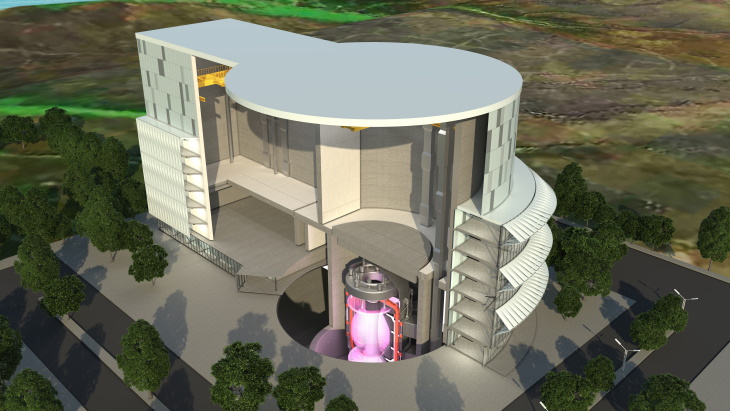Digital twin of STEP fusion machine to be created
A collaboration between the UK Atomic Energy Authority (UKAEA), Dell Technologies, Intel and the University of Cambridge will explore how supercomputers and artificial intelligence technologies with advanced predictive capabilities can deliver a 'digital twin' of the UK's prototype fusion power plant design.

A cutaway of the STEP fusion plant (Image: UKAEA)
The UKAEA carries out fusion energy research on behalf of the UK government, overseeing the country's fusion programme, including the MAST Upgrade (Mega Amp Spherical Tokamak) experiment as well as hosting the Joint European Torus (JET) at Culham, which is operated for scientists from around Europe. It is also developing its own fusion power plant design with plans to build a prototype known as STEP (Spherical Tokamak for Energy Production) at West Burton in Nottinghamshire, which is due to begin operating by 2040.
The engineering designs of STEP will be developed in a highly immersive and connected virtual environment, known as the 'Industrial Metaverse'.
The digital twin will enable STEP's scientists and engineers to create a robust design in the virtual world to ensure ecosystem readiness, value for money and to help STEP achieve its goal of delivering electricity to the grid in the 2040s.
"Exascale computing - the next generation of computing technology - will provide powerful analytics to test STEP's initial concepts," UKAEA said. "The collaboration brings together world-class research and innovation and supports the government's ambitions to make the UK a scientific and technological superpower. It aims to make the next generation of high performance-computers (HPC) accessible, practical to use and vendor agnostic."
"Exascale supercomputing, and the advent of the 'AI era' are essential and potentially transformative milestones that will help the UK to ensure STEP achieves its mission to connect fusion power to the national grid in the early 2040s," said Rob Akers, Director of Computing Programmes at UKAEA. "These powerful technologies will allow us to embed robustness, flexibility, and resilience into the STEP design."
Adam Roe, EMEA HPC Technical Director at Intel, added: "Planning for the commercialisation of fusion power requires organisations like UKAEA to utilise extreme amounts of computational resources and artificial intelligence for simulations. These HPC workloads may be performed using a variety of different architectures, which is why open software solutions that optimise performance needs can lend portability to code that isn't available in closed, proprietary systems. Overall, advanced hardware and software can make the journey to commercial fusion power lower risk and accelerated - a key benefit on the path to sustainable energy."
Paul Calleja, Director, Research Computing Services at the University of Cambridge, noted that the Cambridge Open ZettaScale Lab in partnership with Intel, Dell, UKAEA and a team of HPC experts from across UK Research & Innovation have been working together for the past two years on a world leading co-design activity called Project Dawn. This project aims to design and prototype a candidate UK exascale class converged AI and simulation GPU/CPU supercomputer, with the computation power capable of helping UKAEA meet it its vast computational requirements.
"This project demonstrates the crucial role supercomputing will play in accelerating the energy transition, advancing decarbonisation and ensuring energy security," said Tariq Hussain, Head of UK Public Sales at Dell Technologies.
Researched and written by World Nuclear News
- China Institute of Atomic Energy
- Nuclear Power Institute of China
- Southwestern Institute of Physics
- China Nuclear Power Operation Technology Corporation, Ltd.
- China Nuclear Power Engineering Co., Ltd.
- China Institute for Radiation Protection
- Beijing Research Institute of Uranium Geology (BRIUG)
- China Institute of Nuclear Industry Strategy (CINIS)
- China Nuclear Mining Science and Technology Corporation


